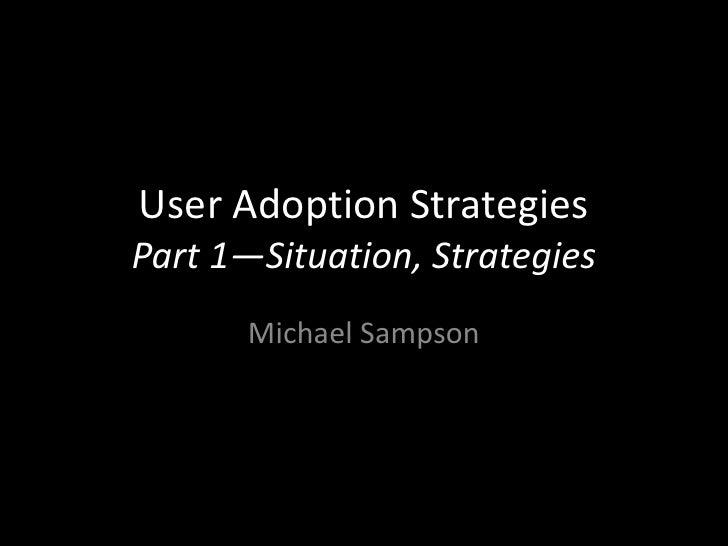What is user adoption strategy
They transfer from an old system and adopt a system that is newer, better, faster, more comprehensive, and altogether more efficient. We found the most significant threats to be: The big issue is always the ticklish time when you transfer from an old system to a new one.
Resistance to change is nothing new. Without a good strategy, you will not get the seamless transition you are hoping for. There will be dissatisfaction, frustration, technical problems, and general chaos. User adoption strategies are so important that a range of terms have been coined to describe them and many books have been written on the subject.
Yep, you start with one big bang. In other words, you set the date, and you dive right in.
Planning for Successful User Adoption | The MITRE Corporation
The old system is abandoned, and the new one is adopted. Big Bang adoption has its advantages. You get everyone on the same page on the same day, and they run with it.
To succeed with Big Bang user adoption, training and orientation are key. Before the starting gun, everyone knows exactly what is going to happen, how it affects them and the way they will work, and how to use the software. All their questions have been answered, and all their concerns have been addressed. The software itself may influence your choice.
The more user-friendly the new system is, the more likely you are to choose this strategy. With complex systems that are less easy to learn, Big Bang adoption can result in chaos. Parallel adoption means that two systems will be run simultaneously during a transition period. The advantage of parallel adoption is that users get a chance to get used to the new system. If they get stuck, they can always transfer to the old system until they get the support they need.
The disadvantage of parallel adoption is that you now have two systems to monitor: Again, staff needs to be aware of the strategy, and there may be times when they need to communicate whether work has been done using the old or new system to avoid confusion. One of its drawbacks is that people may stick to using the old, familiar system for as long as possible rather than adopting the new, improved one.
In phased user adoption, management drip feeds the change into work systems over a period of time. For example, a specific task or a specific team may transition to the new system, and once that is going smoothly, the next phase is implemented.

The change-over is ramped up until all tasks or all teams are using the new system. Phased adoption usually results in a more organized transition than parallel adoption.
Everybody knows what should be done with the new system, and what the cut-off date for the old system is. The user adoption strategy your company chooses will be based on the goals the company wants to achieve and the type of system that is being adopted. Examples of factors influencing the choice include:.
User Adoption Strategies: The Central Desktop Approach – The Michael Sampson Co.
Regardless of the user adoption strategy, the process itself will be achieved through the following steps. User adoption of Tallyfy is easier than you might think. Firstly, you have customized support at your fingertips if you need it. Tallyfy has been designed for user-friendliness, so the training and orientation process are easily accomplished.
Within the system itself, provision is made for reporting, allowing for efficient communication of relevant information to the right people. The workflow you implement is designed by your company for your company, and if there is a need for adjustments, these are easily accomplished and communicated. Finally, analysis of the workflows you implement using Tallyfy is simple.
All the analytics are there for executives and managers to study and evaluate. Some software systems are so complex that phased or parallel user adoption takes years to finalize, but with Tallyfy, full adoption can be achieved quickly, effectively, and seamlessly. You can even use Tallyfy as a means of tracking and evaluating user adoption of other types of software, facilitating an easier transition. Simply request your demo and discover how Tallyfy can become the best change management, business process improvement , and user adoption tool you could imagine.
Your email address will not be published. Subscribe to our newsletter. We created Tallyfy to help people like you track important repeatable processes in one place, without the mess of emails and spreadsheets. Definition — What is User Adoption? Actually, it can be a little more complex than that.

User Adoption Strategies User adoption strategies are so important that a range of terms have been coined to describe them and many books have been written on the subject. Big Bang Adoption Yep, you start with one big bang. Parallel Adoption Parallel adoption means that two systems will be run simultaneously during a transition period. Phased adoption In phased user adoption, management drip feeds the change into work systems over a period of time. Tallyfy was created to help you track important business processes like onboarding and approvals in one place, without the mess of emails and spreadsheets.
User Adoption Strategies - Plan for Software Implementation Success
Business Process Management Workflow Software Customer Experience Software Lean Six Sigma Change Management Collaboration Software Workflow Automation Governance Risk and Compliance Operations Management Operational Excellence Continuous Improvement.
Culture and Adoption , Definitions tags: Leave a Reply Cancel reply Your email address will not be published. PRODUCT Features Solutions Customers Pricing Integrations Help and FAQs API Terms and Legals. COMPANY Submit RFP or RFI About Contact Guides Press and PR Blog Partners Careers. Are you ready to conquer your mountain of tasks?
Hi there - I'm Amit, founder of Tallyfy We created Tallyfy to help people like you track important repeatable processes in one place, without the mess of emails and spreadsheets.